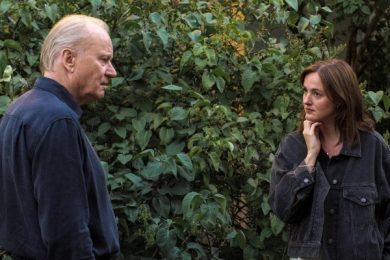Henry Selick has directed a lot of animated films that you love, though you may not know it. James and the Giant Peach, Coraline, and his most famous film, The Nightmare Before Christmas have become so intertwined with the Tim Burton aesthetic (Burton also produced both Christmas and Peach), that many thought (and continue to think) that Burton himself was the director. Selick shares Burton’s taste for gothic romanticism and German Expressionist set design, though Selick has less of a stomach for the truly grotesque. Burton’s formerly successful formula has stalled out in the last decade, and perhaps that’s why Wendell & Wild is the first film Selick has released in thirteen years. With one benefactor out of commission, on comes another in the form of Jordan Peele. Producing the film and co-writing the script, Peele proves a seamless collaborator with Selick, both supporting and enhancing the director’s singular vision.
The story is about a young girl named Kat (Lyric Ross), who’s traumatized when her parents die in a tragic car accident in which she was the sole survivor. Years later, Kat has been in and out of various juvenile detention centers, only to end up back in her hometown of Rust Bank. She left a frightened orphan but returns a boombox-wielding, green-haired punk rocker who refuses to make friends. Still blaming herself for her parents’ death, she has no interest in attaining any more human attachments. She’s placed in Rust Bank’s Catholic School as part of a program for at-risk youth. Father Best (James Hong) runs the school and is happy to accept Kat – and the subsidized money that comes with participating in the program. This supposedly philanthropic effort is actually run by the Klaxon family, who want to open a private prison in Rust Bank, but need the prisoners to turn a profit. Once a town of great spirit and economy, Rust Bank has turned into a wasteland, with the Klaxons sucking up any leftover goodwill with their prison plans.
The Wendell and Wild of the title refers to two demons, voiced by Keegan-Michael Key and Peele, respectively. They are the sons of Buffalo Belzer (Ving Rhames), who runs a bustling amusement park in the afterlife. Wendell and Wild have their own ambitions of making a theme park, but they’re instead forced into servitude, perpetually applying hair cream to the dying sprouts on Belzer’s massive balding head. They see their opportunity to break free of their father’s strict rules in Kat, who becomes a hell maiden after getting marked in class. Kat’s teacher, Sister Helley (Angela Bassett) is also a hell maiden and tells Kat to keep her marking a secret. But Kat is swayed by Wendell and Wild, who visit her in a dream, and convince her to bring them to the world of the living with empty promises of resurrecting her parents. So eager to undo her past, Kat agrees to use her marking to help them leave Belzer’s grip, while their only aspiration is to fulfill their dreams of designing the ultimate amusement park.
Wendell & Wild‘s script juggles many themes and while the film is admirable in its ideals, it is mostly a vessel to deliver Selick’s indelible cinematic style, which is ample and on great display here. Especially within the world of commercial animated films, Wendell & Wild will stand out with its audaciousness and flair. The ardent discipline of the stop-motion process is renowned, but this film’s casual looseness belies the intensity of the filmmaking. Its serious themes are melted into its alluring imagery, and its moral certitudes are as busy as the animation. You probably don’t see many children’s films these days that tackle carceral injustice, and Wendell & Wild may not give itself an appropriate amount of time and care to really tackle these issues with full intellectual heft but it is earnest and curious in its tonal ambition. More than anything, Wendell & Wild is simply one of the coolest looking animated films you can watch this year, and that counts for a lot.
Directed by Henry Selick










